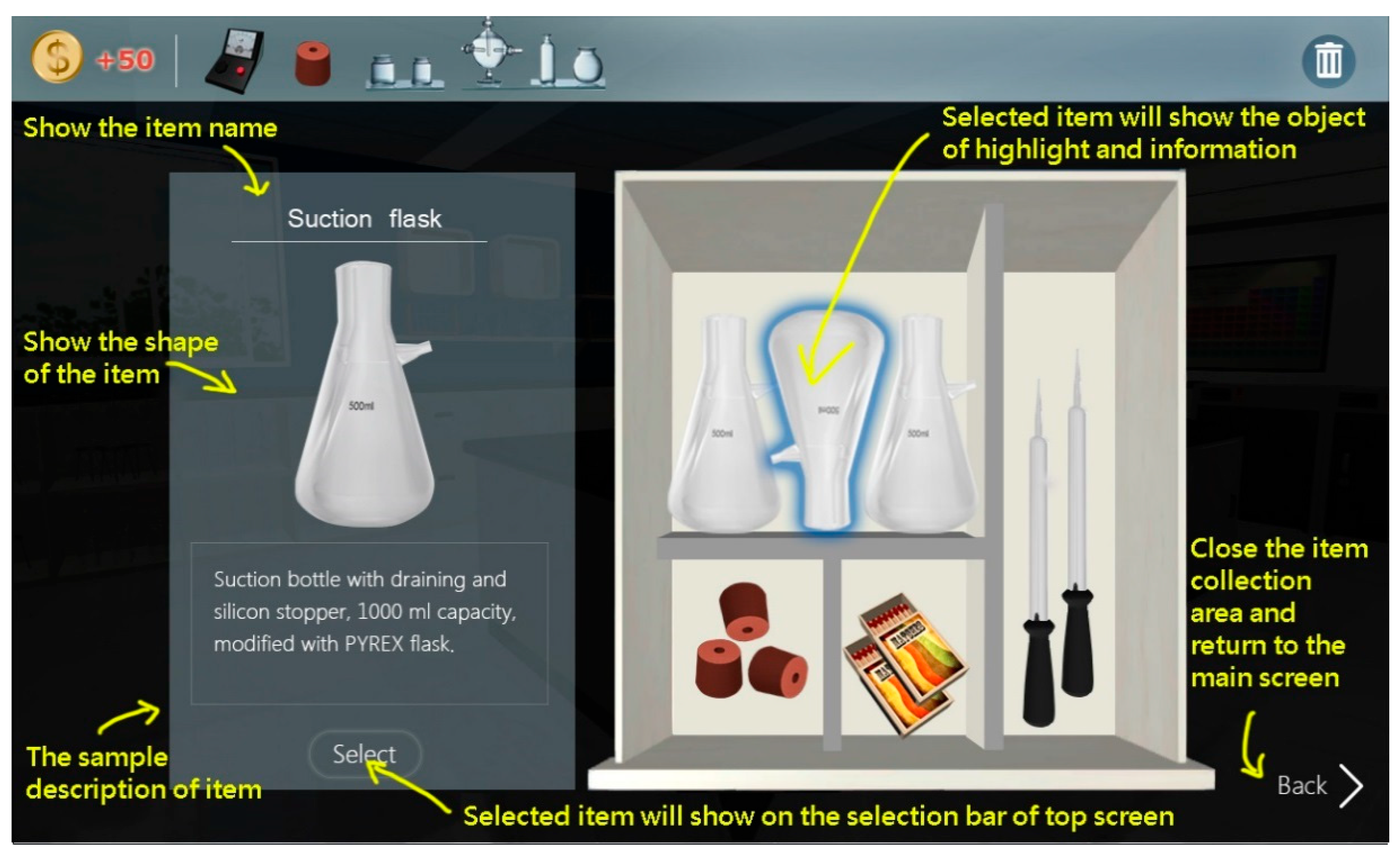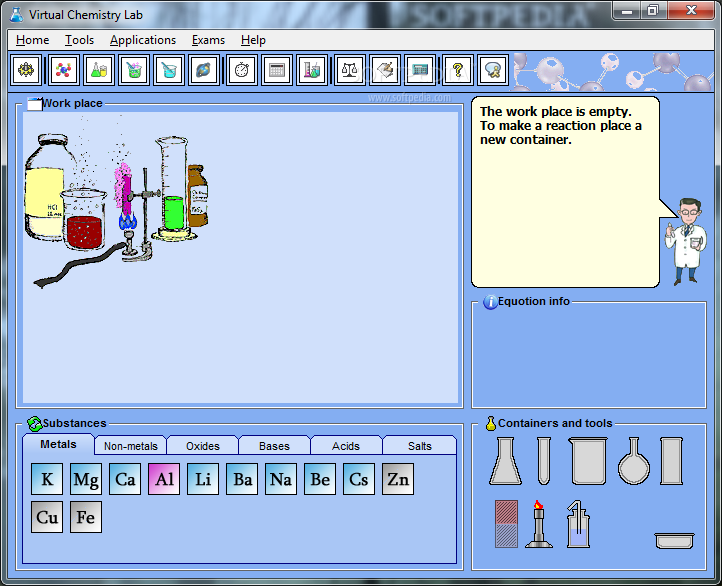Virtual Chemistry Lab Software

The Virtual Lab is an online simulation of a chemistry lab. It is designed to help students link chemical computations with authentic laboratory chemistry. The lab allows students to select from hundreds of standard reagents (aqueous) and manipulate them in a manner resembling a real lab. More information and offline downloads.
Please scroll below to find our collection of pre-written problems, they have been organized by concept and ranked by difficulty.

Stoichiometry
Glucose Dilution Problem
In this activity, students use the virtual lab to create a 0.025M glucose solution from a standard 1M glucose solution. First, they calculate the correct volumes of 1M glucose solution and water to mix together…
Acid Dilution Problem
In this activity, students use the virtual lab to create 500mL of 3M HCl solution from a concentrated stock solution of 11.6M HCl. They must first calculate the correct volumes of 11.6M HCl solution and water to…
Cola and Sucrose Concentration Problem
In this activity, students use the virtual lab to prepare a sucrose solution for a soda recipe. They next calculate the concentration of their solution in terms of molarity, percent mass and density. Finally, they…
Making Stock Solutions from Solids
In this activity, students use the virtual lab to create stock solutions starting from solid salts. Students must first calculate the correct amount of solid to make the solution. Next, they prepare the solution…
Identifying the Unknown Metal (Metals Density Problem)
In this activity, students use the virtual lab to identify an unknown metal by measuring its density and comparing their measurements to the densities of known metals.
Identifying an Unknown Liquid from its Density
In this activity students use the virtual lab to design an experiment to determine the identity of mislabeled bottles using the densities of the solutions inside.
Alcohol Density Problem
Determine the concentration of an alcohol solution from its density.
Gravimetric Determination of Arsenic
Set in the context of ground water contamination in Bangladesh, this stoichiometry and analytical chemistry activity examines the issues around identifying wells contaminated with arsenic. (Part of a larger online…
Determining Stoichiometric Coefficients
In this activity, students use the virtual lab to determine how 4 unknown substances react with each other including their stoichiometric coefficients.
Stoichiometry and Solution Preparation Problem
In this limiting reagents problem, students mix together solutions in different ratios in an attempt to produce a final solution that contains only 1 product.
Textbook Style Limiting Reagents Problems
Textbook-style practice limiting reagent exercises with that can be used as a way to 'predict and check' your answers using the virtual lab.
Textbook Style Limiting Reagents Problem II
In this activity, students practice with experiments involving limiting reagents and the test their knowledge to determine the concentration of an unknown solution.
Predicting DNA Concentration
In this limiting reagents problem, students are given specific concentrations of DNA solutions and are asked to predict what products and reactants will remain after a specific volumes are mixed and reaction has…
Unknown Concentration of DNA Solution Problem
In this advanced limiting reagent problem, students use the virtual lab to determine the concentration of a solution of DNA by reacting it with known amounts of a fluorescent dye which binds to the DNA.
The Mole, Molarity, and Density
Reaction Stoichiometry and Limiting Reagents
Thermochemistry
Camping Problem I
In this part of the MRE scenario, students measure the enthalpy of a reaction.
Camping Problem II
In this part of the MRE scenario, students determine change in the enthalpy of a reaction as the concentration of reactants are varied.
ATP Reaction (Thermochemistry and Bonding)
Determine the enthalpy of the ATP reaction.
Determining the Heat of Reaction in Aqueous Solution
In this activity, students perform an experiment to determine the heat of a reaction.
Coffee Problem
Use the virtual lab to determine how much milk to add to hot coffee to reach the desired temperature
Measuring the heat capacity of an engine coolant.
As an analytical chemist at a company developing new engine coolants your task is to determine the heat capacity of a newly developed product and then to determine if its heat capacity is greater of less than that…
Measuring the heat capacity of an engine coolant II (Advanced version)
Measure and compare the heat capacity of an unknown liquid with an unknown density.
Camping Problem III
In this part of the MRE scenario, students create solutions that when mixed, increase to a certain temperature.
Heats of Reaction - Hess' Law
Download def jam fight for ny ppsspp pc. This activity provides a demonstration of Hess' Law using three reactions: the solubility NaOH in water, the solubility NaOH in HCl and the reaction of a solution of HCl and a solution of NaOH.
Energy and Enthalpy
Equilibrium
Cobalt Chloride and LeChatlier’s Principle
In this activity, students safely explore the equilibrium reaction of the cobalt chloride reaction.
DNA Binding Problem
In this activity, students explore equilibrium constants in biochemical systems by measuring the binding constant of a DNA-Dye reaction.
LeChatlier's Principle
Equilibrium Calculations
Acid-Base Chemistry
Strong Acid and Base Problems
Textbook-style strong acid and base problems that can be checked using the Virtual Lab.
Determination of the pH Scale by the Method of Successive Dilutions
This activity was created as an accompaniment to an in-class demonstration of the method of successive dilutions using HCl, NaOH, a pH meter, and universal indicator solution. After the demonstration, students…
Weak Acid and Base Problems
Textbook-style weak acid and base problems that can be checked using the Virtual Lab.
Determining the pKa and Concentration Ratio of a Protein in Solution
Use the virtual lab to determine the pKa of a protein then create a buffer solution with a specific concentration ratio of the protein in its protonated/ unprotonated form.
Unknown Acid and Base Problem
In this exercise, students graph the titration curve of an unknown acid and base to determine their pKa’s and concentrations.
Creating a Buffer Solution
An exercise to design a buffer solution with specific properties.
DNA - Dye Binding: Equilibrium and Buffer Solutions
Students examine equilibrium and buffer solutions in a biological setting.
Determining the pKa and Concentration Ratio of a Protein in Solution
Use the virtual lab to determine the pKa of a protein then create a buffer solution with a specific concentration ratio of the protein in its protonated/ unprotonated form.
Standardization of NaOH with a KHP solution: Acid Base Titration
Use the Virtual Laboratory to standardize an unknown NaOH solution (approximately 0.2M) to four significant figures via titration with 25.00 mL of a KHP standard solution.
Strong Acids and Bases
Weak Acids and Bases
Buffer Solutions
Acid/Base Titrations
Solubility
Determining the Solubility Product
Determine the solubility product constatnt (Ksp) for various solids.
Temperature and the Solubility of Salts
Examine the solubilities of salts based on temperature.
Determining the solubility of copper chloride at different temperatures
GIven the solubility of CuCl at 2 different temperatures, predict its solubility at a third temperature. Then test your prediction by creating the solution in the virtual lab
Solubility Product
Oxidation/Reduction and Electrochemistry
Exploring Oxidation-Reduction Reactions
Design an experiment to order Cu, Mg, Zn and Pb from strongest to weakest reducing agent.
Standard Reduction Potentials
Analytical Chemistry/Lab Techniques
Standardization of NaOH with a KHP solution: Acid Base Titration
Use the Virtual Laboratory to standardize an unknown NaOH solution (approximately 0.2M) to four significant figures via titration with 25.00 mL of a KHP standard solution.
Unknown Silver Chloride
Determine the concentration of Silver ion in a Silver Nitrate solution using gravimetric analysis
Acid/Base Titrations
Gravimetric Analysis
Virtual Chemistry Lab Software
Teach Chemistry with Labster Virtual Labs The future of education at your fingertips Labster gives students access to a realistic lab experience that will let them perform experiments and practice their skills in a fun and risk-free learning environment. Watch the video to learn what Labster can offer. Virtual Lab is an online resource for teaching and learning chemistry. It contains a large number of activities which can be simulated for learning basic chemistry. There are a number of experiments in the virtual lab which can be tried. Virtual Lab, free and safe download. An interactive chemistry lab simulation for Windows. This software program is potentially malicious or may contain. We Create Software for Comparative Medicine Research Virtual Chemistry fosters research environments where investigators can focus on science while remaining transparent and efficient in their use of important resources. Products Virtual Chemistry's Mosaic platform. Virtual Computational Chemistry Laboratory. On-line software. ALOGPS 2.1. is the most accurate program to predict lipophilicity and aqueous solubility of molecules.